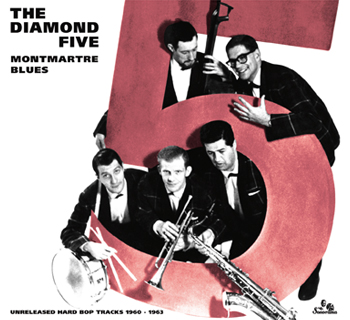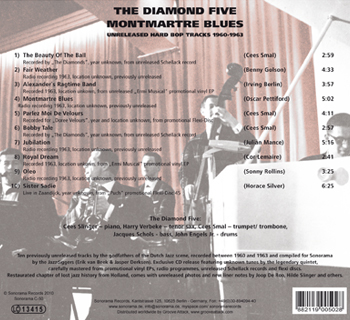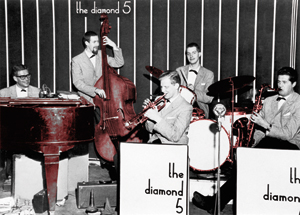CD: Sonorama C-50
THE DIAMOND FIVE – Montmartre Blues


D 01
Track
Composer
Time
01
The Beauty Of The Ball
Cees Smal
2:59
Recorded by „The Diamonds“, year unknown, from unreleased schellack record
02
Fair Weather
Benny Golson
3:57
Radio recording 1963, location unknown, previously unreleased
03
Alexander`s Ragtime Band
Oscar Pettiford
3:57
Recorded 1963, location unkown, from unreleased „Ermi Musical“ promotional vinyl EP
04
Montmartre Blues
Oscar Pettiford
5:02
Radio recording 1963, location unknown, previously unreleased
05
Parlez Moi De Velours
Cees Slinger
4:11
Recorded for „Doree Velours“, year and location unknown, from promotional flexi-disc
06
Bobby Tale
Cees Smal
2:57
Recorded by „The Diamonds“, year unknown, from unreleased Schellack record
07
Jubilation
Junior Mance
5:16
Radio recording 1963, location unknown, previously unreleased
08
Royal Dream
Cor Lemaire
2:41
Recorded 1963, location unkown, from „Ermi Musical“ promotional vinyl EP
09
Oleo
Sonny Rollins
3:25
Radio recording 1963, location unknown, previously unreleased
10
Sister Sadie
Horace Silver
6:25
Live in Zaandijck, year unknown, from „Puch“ promotional flexi-disc 45
The Diamond Five:
Cees Slinger – piano, Harry Verbeke – tenor sax, Cees Smal – trumpet/ trombone
Jacques Schols - bass, John Engels Jr. - drums
Compiled by the Jazzdiggers (Jasper Derksen & Erik van Beek)
Cees Slinger – piano, Harry Verbeke – tenor sax, Cees Smal – trumpet/ trombone
Jacques Schols - bass, John Engels Jr. - drums
Compiled by the Jazzdiggers (Jasper Derksen & Erik van Beek)

About “The Diamond Five”:
Cees Slinger (1929 -2007) was the founder and leader of the hard bop combo "The Diamond Five" featuring the trumpeter and trombonist Cees Smal (1927 - 2001), the tenor saxophonist Harry Verbeke (1922-2004), bassist Jacques Schols, and drummer John Engels, playing at the Jazz Club "Sheherazade" in Amsterdam. Before the foundation some of the musicians already played as the "The Diamonds" at the „Jig Rhythm Club“ in Haarlem, with Verbeke, Smal and the initial bassist Dick van der Capellen. To avoid confusion with the singing group "The Blue Diamonds", they changed their name to "The Diamond Five". From October 1958 to April 1962 the band played at the „Sheherazade“, that they had also taken over. Van der Capellen took no part in the takeover, as he had previously survived a car accident and was replaced by Schols. In 1962 the musicians sold their club and went on tour, because the music taste changed to Beatlemania. Although Cees Slinger took a job in the steel industry he kept playing. Together with Jacques and John he made two LPs with Ben Webster. In 1973 the LP „Back Together“, featuring Greetje Kauffeld, came out. In 1974 he quit the job and became again a full-time jazz musician. The quintet jammed with many American jazz artists like Stan Getz, Phil Woods, Quincy Jones and Don Byas after their official appearances and even played at the Concertgebouw in Amsterdam in 1963. Between 1959 and 1962, several already documented vinyl EPs were released on labels such as Fontana or Omega and were summarized for the 1978 compilation album "Amsterdam Blues". In 1964 they recorded the LP "Brilliant", which was later reissued on Fontana.
Liner notes by the „Jazzdiggers“ (about this collection of unreleased material, 2010):
The advantage of working in a record store is that you are very close to the source. So one day a colleague gave us an album by The Diamond Five called “Amsterdam Blues” which was a collection of their first EPs. We were absolutely blown away! This was as good if not better than other records we had heard by European artists from Poland, Scandinavia, England and Germany but .... this was from Holland! Needless to say we started to look for any other material and tried to get our hands on all the records this band had ever released. When we heard their first album "Brilliant" we knew that we had to let other jazz fans know how great this band was. This resulted in a re-release, interviews in major Dutch newspapers and magazines and a TV appearance in Holland's best watched talk show “De Wereld Draait Door”. But most important to us was meeting the remaining original members John, Jacques and the late Cees. Hearing them talk about the old days and seeing original photographs from that period was an absolute thrill. Just when we thought we had all of The Diamond Five’s records Jacques mentioned that they had also once recorded a tune for a company as an advertisement for wallpaper or something and that it might have been released on a flexi disc. When asking other collectors about it nobody seemed to have ever seen or heard it. Most knew of the Puch flexi disc with the track Sister Sadie on it but not this one! But we didn't give up and finally we found a copy of a flexi disc for Velours Dorée curtains. Filled with anticipation we put the needle to the grooves. And the music? ... no doubt ... this was the Diamond Five! Up until now it’s the only copy we’ve ever seen but they must be out there. As for the live recordings presented here, these were handed to us by a fellow collector who knew how much we were into this music. So here it is, an album with the most rare and excellent music by the godfathers of the Dutch jazz scene. We hope it will excite you as much as it did excite us. Enjoy, Jazzdiggers (Jasper Derksen & Erik van Beek)
Extracts from the memories of Cees Slinger for „Highlights from the 60s“ (1978):
Naturally, when the five of us first got together in October 1958 for a one-month gig in Amsterdam`s Sheherazade Club, we had no way of knowing that 20 years later we would still, or rather again, be together. Then, all five of us had only the Diamond Five to be loyal to – musically speaking, of course. None of us held any other jobs; the Sheherazade was our one and only employer. Monthly engagements were common practice at that time and when we started out in the club it was like something definite, something to dedicate yourself to, if not for life then at least for a long time. We were really together, six days a week. Sure there were other gigs too, but they were still gigs for the group as a whole, like the weekly radio broadcasts, the European festivals, the one-niters, and other club dates. Basically we feel that the music we played in the sixties was good music, honest, straightforward bebop. Those were crazy times. Like when Stan Getz came over to Amsterdam to play with us for four days. Or those two weeks when the „Free and Easy“ show was in town and all the cats from the show would hurry down to the „Zade“ every night to catch the last set and sit in with us: Clark Terry, Sahib Shihab, Phil Woods, Melba Liston, Quincy Jones, to name a few. It was whispered afterwards that the show went bankrupt because tempos of all the tunes were rushed too much in order to get off the stand fast. Then in 1962 boredom struck us and when we left the Sheherazade and split up, we did so with the unanimous feeling that we had had enough of it. We had seen too much of each other for too long; we needed some fresh experiences; we had also become conceited. But these tunes and the way they are played are very representative of our way of playing night after night in the Sheherazade. And almost every day each one of us meets people who were there, who cherish the memory of those days and hope they may some day return. (Cees Slinger)
Liner notes by Joop de Roo, former head of entertainment for radio and television, Hilversum, the Netherlands (2010):
During World War II it was extremely difficult for music – lovers and musicians in Holland to keep themselves well informed about the newest developments in the American music scene. Nobody had a radio in those days and if you had one it was not allowed by the occupying power to listen to it. Consequently the music that was first performed publicly after the liberation was based on the Dixieland genre, of course led by Peter Schilperoort’s Dutch Swing College Orchestra. In 1950 a new group was formed: The Diamond Five lead by Cees Slinger on piano, with Cees Smal on trumpet/valve trombone, Harry Verbeke on tenor, Dick van der Capellen, later Jacques Schols on double bass and Cees See or John Engels on drums. In a short period they managed to develop themselves into a perfect combo which was able to perform the so called hard-bop repertoire to American standards. In the fifties they started an engagement in the jazzclub Sheherazade in Amsterdam. In the following years they even became the owners, but unfortunately the place had to close down in 1962 and in 1964 The Diamond Five disbanded. By the way. The Hague was not the only city where jazz was promoted after the war. The city of Haarlem is worthy of attention. Many top Dutch jazz musicians came from that city, such as: Ruud and Han Brink, Erik en Bart van Lier, Cees Smal, Harry Verbeke, Ferdinand Povel and Eric Ineke. I don’t want to hold back a personal experience. In the fifties I was visiting an old fellow student in Groningen who wanted to let me hear an EP he had just bought. Of course the question came: do you recognize anything or anybody? At that moment it was totally new to me, I listened one more time, but I didn’t recognize any of the players. So I finally said that I thought it was a new American group. But it actually turned out to be our own Diamond Five! Gladly I would like to close up this short piece with a criticism from those glorious days of The Diamond Five: ‘They are the only European formation which can perform hard-bop to an American standard. “Chapeau”! (Joop de Roo)
Jazzdiggers would like to thank: Jacques Schols, John Engels jr, Cees Slinger, Cees Smal, Harry Verbeke, Bjorn, Ger, Hilde Slinger, Ekkehart, Roskow. Producer for reissue: Ekkehart Fleischhammer, sound restoration by Roskow Kretschmann at Audiomoto, unreleased photos from the collection of Hilde Slinger, cover design by Patrick Haase (rab.bit) and Ekkehart Fleischhammer.
